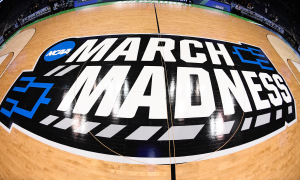After March Madness Live’s Success, iStreamPlanet’s Mio Babic Is Highly Encouraged by Cloud Delivery Workflows
Confidence in the cloud helped the streaming product rack up record consumption numbers
Story Highlights
It was another winning year for one of the sports-video industry’s top live-streaming products: March Madness Live. The 2019 men’s hoops tourney set all-time records in live streaming (with more than 100 million streams, a 31% increase over last year) and live hours consumed (more than 24 million, a 29% spike).
 The Sports Emmy-winning product is supported on the backend by the video-delivery experts at iStreamPlanet (which is also owned by WarnerMedia Entertainment). We caught up with iStreamPlanet President/CEO Mio Babic to go under the hood on this year’s workflow and discuss why confidence in delivery via the cloud is changing the game.
The Sports Emmy-winning product is supported on the backend by the video-delivery experts at iStreamPlanet (which is also owned by WarnerMedia Entertainment). We caught up with iStreamPlanet President/CEO Mio Babic to go under the hood on this year’s workflow and discuss why confidence in delivery via the cloud is changing the game.
What was different or unique about this year’s streaming delivery? iStreamPlanet has been a part of this project for some time, but what was notable about this effort?
I think with the attention to and proliferation of streaming services — from WarnerMedia to Disney to Hulu — there’s a lot of noise in this industry. That is because audiences are clearly shifting to online consumption. We had nearly a million concurrent users at 12:30 a.m. ET on a Sunday. I have never seen that in 20 years of doing this. It’s a sign of change in times of consumption behaviors.
With that understanding, we felt it was really, really important to build and deliver a truly broadcast-quality experience. Ensure that consumers get that high quality on any device for any of these games. On that same level, when you have this great audience, you want to capture that from a monetization standpoint and deliver the highest-quality advertising experience that’s seamless and perceived as less of an annoyance and more of a value exchange for seeing the content.
We spend a lot of time asking, How do we make this year’s March Madness Live experience even more robust and even more reliable with even more options? We can add all of that to the online experience, but it needs to be, performance-wise, on par with the broadcast experience.
Technologically, are you pleased with the progress of any part of the workflow chain over the past couple of years?
I would say it’s confidence in the cloud. Doing live video in the cloud is still very difficult. The cloud is maturing very rapidly, but there are still, sort of, things that occasionally just happen in the cloud environment that can be concerning. You have to have the right tooling, processes, and architecture to make sure that you’re not exposed to some of those things. I think it’s worth highlighting the maturity of the cloud. It’s progressing in a way that we can now rely on it to 100%-exclusively deliver the experience.
We relied on multiple cloud partners, and we made sure that we have a fully redundant workflow on both the East Coast and the West Coast. So, even if an entire cloud region would have problems, we would still have a different region and a different cloud to deliver the experience.

iStreamPlanet’s Mio Babic: “Last year, we were even questioning if we wanted to go fully all-in on the cloud. But, in the last 12 months or so, the confidence level in leveraging the cloud has increased tremendously.”
I’m interested in more of your macro thoughts on the state of the cloud in live sports production. Coming out of the NAB Show, there was a lot of positive feelings about it. As you mentioned, it sounds like the belief is there for many. When you look at this segment of the business and in the context of your experiences at NAB 2019, where do you think we are? Should we be pleased?
The one promise the cloud has given is scale. To some extent, I was less concerned with managing things in the cloud than I was with being able to scale things. Using an event like March Madness, it extends over multiple weeks, and you have several weeks of end-to-end testing, so you need a pretty decent-size resource for about 2½ months. Provisioning all of the resources and maintaining that equipment is not very cost-efficient. Scale was always a compelling story for us when we considered the cloud.
The interesting thing is, we were one of the first companies to build their cloud media processing and we [were] doing it as early as 2012, when many were still firm believers that appliance and hardware were the only way to go. We have come a long way as an industry since then, and what’s very encouraging to us is seeing a tremendous amount of commitment from cloud partners to work with us specifically on these media workflows.
In the cloud, there are so many different workflows: healthcare, finance, manufacturing. Media, and especially live media, is a challenge because you can’t have any latency; you can’t have any packet loss. Every bit has to be delivered in real time. So it’s encouraging to see the tremendous commitment by cloud folks to focus on media workloads and solve those problems with us along the way. That really translated for this March Madness because we relied on the cloud to deliver, and we have seen a meaningfully better performance even just over last year. Last year, we were even questioning if we wanted to go fully all-in on the cloud. We can’t take a risk on this event so we sort of hedged our bets. But, in the last 12 months or so, the confidence level in leveraging the cloud has increased tremendously.
In your opinion, what’s next for March Madness Live? How might it look different in a couple of years?
What you will see is even higher quality of video. HDR (high dynamic range) is knocking on our doors, and it’s something that we are investing heavily in. Looking at an HDR image and a 4K video source next to each other, anyone can see a difference in HDR. Put that in front of a regular consumer, and they will look at the 1080p HDR and say that looks better. The colors are much richer. Over the next couple of years, you will see that higher quality of video and lower latency. Latency will get to where it’s at least matched with broadcast video, if not better than broadcast video.
I would also say that, in the use of data, we are just scratching the surface of what is possible. Now we’re integrating metadata around captioning and ad insertion, but you also have all of these statistics and play-by-play data. You’ll see more of that used to make even more-engaging experiences for the consumers.
Lastly, you’ll see more targeted advertising that’s more relevant to the consumer.
